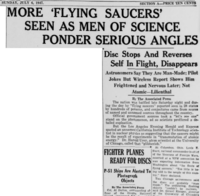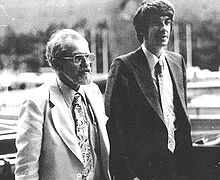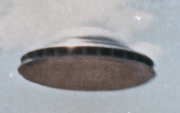Interdimensional UFO hypothesis
This article needs additional citations for verification. (June 2022) |
The interdimensional hypothesis is a proposal that unidentified flying object (UFO) sightings are the result of experiencing other "dimensions" that coexist separately alongside our own[1] in contrast with either the extraterrestrial hypothesis that suggests UFO sightings are caused by visitations from outside the Earth or the psychosocial hypothesis that argues UFO sightings are best explained as psychological or social phenomenon.
The hypothesis has been advanced by ufologists such as Meade Layne,[2] John Keel,[3] J. Allen Hynek, and Jacques Vallée.[4][1] Proponents of the interdimensional hypothesis argue that UFOs are a modern manifestation of a phenomenon that has occurred throughout recorded human history, which in prior ages were ascribed to mythological or supernatural creatures.[5]
Jeffrey J. Kripal, Chair in Philosophy and Religious Thought at Rice University, writes: "this interdimensional reading, long a staple of Spiritualism through the famous 'fourth dimension', would have a very long life within ufology and is still very much with us today".[6]
History
[edit]Pre-modern history
[edit]Concepts similar to ”other dimensions” exist amongst various religious and mystical traditions, such as Islamic mysticism known as Sufism. In this tradition, the concept al-ghayb refers to the hidden, unseen, and invisible, and encompasses a range of important phenomena in Islam and in the everyday lives of Muslims.[7] Within this mystical tradition, there is a concept of a hidden multilayered reality or world known as 'ālam al-mithāl, or “the world of similitude” which is considered to be an intermediary realm between the physical world (‘ālam al-shahada) and the purely spiritual world (‘ālam al-malakut). It is believed within this dominion exists everything unseen including intelligent non-human entities, known in Islam as jinn and angels.

In the 19th century, various spiritualists believed in "other dimensions". During the Summer of 1947, spiritualists adapted the "other dimensions" to explain recent tales of "flying discs".
Background
[edit]In the late 19th century, the metaphysical term "planes" was popularized by H. P. Blavatsky, who propounded a complex cosmology consisting of seven "planes".[6] The term aether ("ether") was adopted from Ancient Greek via Victorian physics that would later be discredited. The term "ether" was then incorporated into the writings of 19th-century occultists.
The "etheric plane" and the "etheric body" were introduced into Theosophy by Charles Webster Leadbeater and Annie Besant to represent a hypothetical 'fourth plane', above the "planes" of solids, liquids, and gases. The term "etheric" was later used by popular occult authors such as Alice Bailey, Rudolf Steiner, and numerous others.[6]
Theorists
[edit]Meade Layne and 'Ether Ships'
[edit]| 1947 flying disc craze |
|---|
 |
| Events |
On July 4, 1947, occultist Meade Layne claimed that flying discs were "etheric".[2] Layne claimed to be in telepathic communication with "people in the saucers", arguing "it is possible for objects to pass from an etheric to a dense level of matter and will then appear to materialize. They then will return to an etheric conditions".[8][2] Layne claimed that "These visitors are not excarnate humans but are human beings living in their own world. They come with good intent. They have some idea of experimenting with earth life."[9] The prior year, it had been reported that Layne consulted a medium who relayed communications from a "space ship named Careeta" that came to Earth from 'an unidentified planet'.[9][10][2]
According to one scholar, Layne coined the term "interdimensional hypostasis" to describe the sightings.[11][additional citation(s) needed] Layne is regarded as the earliest proponent of the interdimensional hypothesis.[2]
John Keel and 'Ultraterrestrials'
[edit]Although the extraterrestrial hypothesis has remained predominant,[12][additional citation(s) needed] by the 1970s, the interdimensional hypothesis began to be embraced by some UFO enthusiasts. Paranormal author and UFO enthusiast John Keel recalled:
I abandoned the extraterrestrial hypothesis in 1967 when my own field investigations disclosed an astonishing overlap between psychic phenomena and UFOs... The objects and apparitions do not necessarily originate on another planet and may not even exist as permanent constructions of matter. It is more likely that we see what we want to see and interpret such visions according to our contemporary beliefs.[13][14]
In his 1970 book UFOs: Operation Trojan Horse, Keel argued that a non-human or spiritual intelligence source has staged whole events over a long period of time in order to propagate and reinforce certain erroneous belief systems. For example, monsters, ghosts and demons, the fairy faith in Middle Europe, vampire legends, mystery airships in 1897, mystery aeroplanes of the 1930s, mystery helicopters, anomalous creature sightings, poltergeist phenomena, balls of light, and UFOs; Keel conjectured that ultimately all of these anomalies are a cover for the real phenomenon.[13][additional citation(s) needed] Keel used the term "ultraterrestrials" to describe UFO occupants he believed to be non-human entities capable of taking on whatever form they want.[additional citation(s) needed]
Hynek and Vallée
[edit]
J. Allen Hynek was an American astronomer who served as scientific advisor to the U.S. Air Force UFO studies: Project Sign, Project Grudge, and Project Blue Book. Hynek pioneered the "Close Encounter" classification system; Hynek had a cameo in Stephen Spielberg's film Close Encounters of the Third Kind.[15] Jacques Vallée, a student of Hynek's, served as the inspiration for the French researcher portrayed by François Truffaut in the film.[16]
In 1975's The Edge of Reality, Vallée and Hynek consider the possibility of what they call "interlocking universes":
VALLÉE: What other wild hypotheses could we make?
HYNEK: There could be other universe with different quantum rules or vibration rates if you want. Our own space-time continuum could be a cross-section through a universe with many more dimensions. ... Think what a hard time you would have convincing an aborigine that right now, through this room, TV pictures are passing! Yet they're here. You have to have a transducer to see them -- namely a TV set. Well, in the same sense there may be interlocking universes right here! We have this idea of space, we always think of another universe being someplace else. It may not. Maybe it's right here."
In his 'landmark' 1969 book Passport to Magonia: On UFOS, Folklore and Parallel Worlds, Vallee argues for a "parallel universe co-existing with our own".[4] The idea was reiterated in Vallée's subsequent writings.[17] Vallée's summarized his objection in his 1990 paper "Five Arguments Against the Extraterrestrial Origin of Unidentified Flying Objects":[18]
- unexplained close encounters are far more numerous than required for any physical survey of the earth;
- the humanoid body structure of the alleged "aliens" is not likely to have originated on another planet and is not biologically adapted to space travel;
- the reported behavior in thousands of abduction reports contradicts the hypothesis of genetic or scientific experimentation on humans by an advanced race;
- the extension of the phenomenon throughout recorded human history demonstrates that UFOs are not a contemporary phenomenon; and
- the apparent ability of UFOs to manipulate space and time suggests radically different and richer alternatives.
In popular culture
[edit]The 2008 action-adventure film Indiana Jones and the Kingdom of the Crystal Skull utilizes the interdimensional hypothesis and describes ancient aliens not flying into space but into ”the space between the spaces".[19][20]
The 2014 movie Interstellar employs a mix of the interdimensional and the time-traveler hypotheses. The bulk-beings[21] who built the tesseract inside the supermassive black hole Gargantua are later revealed to be future humans who have evolved to exist in five dimensions.
See also
[edit]- Fallen angel
- Multiverse
- Spiritualism
- String theory
- Extraterrestrial hypothesis
- Psychosocial hypothesis
- Space animal hypothesis
- Time-traveler hypothesis
- Cryptoterrestrial hypothesis
References
[edit]- ^ a b Laycock, Joseph P. (2021). "Unmasking the Alien Deception: Why Evangelicals Are Studying Ufology". In Zeller, Ben (ed.). Handbook of UFO Religions. Brill Handbooks on Contemporary Religion. Vol. 20. Leiden and Boston: Brill Publishers. pp. 103–115. doi:10.1163/9789004435537_006. ISBN 978-90-04-43437-0. ISSN 1874-6691. S2CID 236696101. Archived from the original on 2021-07-26. Retrieved 2021-07-26.
- ^ a b c d e Reece, Gregory L. (15 August 2007). UFO Religion: Inside Flying Saucer Cults and Culture - Gregory L. Reece - Google Books. Bloomsbury Academic. ISBN 9781845114510.
- ^ Boyle, Tanner F. (December 9, 2020). The Fortean Influence on Science Fiction: Charles Fort and the Evolution of the Genre. McFarland. ISBN 9781476677408. Archived from the original on June 19, 2022. Retrieved June 19, 2022 – via Google Books.
- ^ a b Kline, Jim (9 April 2019). The Otherworld in Myth, Folklore, Cinema, and Brain Science. Cambridge Scholars. ISBN 9781527532908. Archived from the original on 20 June 2022. Retrieved 20 June 2022.
- ^ "History of UFOs". Funk & Wagnalls New Encyclopedia. World Almanac Education Group. 2006.[permanent dead link]
- ^ a b c Kripal, Jeffrey J. (15 November 2011). Mutants and Mystics: Science Fiction, Superhero Comics, and the Paranormal. University of Chicago Press. ISBN 9780226453835. Archived from the original on 15 June 2022. Retrieved 15 June 2022.
- ^ Suhr, Christian (Dec 12, 2013). "AL-GHAYB THE POETICS AND POLITICS OF THE UNSEEN IN ISLAM" (PDF).
- ^ "5 Jul 1947, 1 - The Herald-Sun at Newspapers.com". Newspapers.com. Archived from the original on 27 May 2022. Retrieved 15 June 2022.
- ^ a b "5 Jul 1947, 2 - The Herald-Sun at Newspapers.com". Newspapers.com. Archived from the original on 22 May 2022. Retrieved 15 June 2022.
- ^ "15 Oct 1946, 1 - Hanford Morning Journal at Newspapers.com". Newspapers.com. Archived from the original on 31 May 2022. Retrieved 15 June 2022.
- ^ Laos, Nicolas (May 19, 2016). Methexiology: Philosophical Theology and Theological Philosophy for the Deification of Humanity. Wipf and Stock Publishers. ISBN 9781498233866. Archived from the original on June 15, 2022. Retrieved June 15, 2022 – via Google Books.
- ^ Jacques Vallee (1980). Messengers of Deception: UFO Contacts and Cults. New York: Bantam Books.
- ^ a b Keel, John A. (1973). "Operation Trojan Horse: An Exhaustive Study of Unidentified Flying Objects - Revealing Their Source and the Forces that Control Them". Archived from the original on 2022-06-20. Retrieved 2022-06-20.
- ^ "John Keel". 10 July 2009. Archived from the original on 2022-08-10. Retrieved 2022-07-03.
- ^ Daugherty, Greg. "Meet J. Allen Hynek, the Astronomer Who First Classified UFO 'Close Encounters'". History.com. Archived from the original on May 12, 2019. Retrieved May 28, 2019.
- ^ Tattoli, Chantel. "Jacques Vallée Still Doesn't Know What UFOs Are". Wired. Archived from the original on 2022-06-20. Retrieved 2022-06-20.
- ^ Steven J. Dick (1999). The Biological Universe. Cambridge University Press. pp. 313–320. ISBN 9780521663618.
- ^ Journal of Scientific Exploration, 1990:
- ^ December 20, Lisa Schwarzbaum Updated; EST, 2019 at 06:03 AM. "Indiana Jones and the Kingdom of the Crystal Skull". EW.com. Archived from the original on 2023-06-29. Retrieved 2023-06-29.
{{cite web}}: CS1 maint: numeric names: authors list (link) - ^ Child, Ben (2022-07-15). "Why there's no way back for George Lucas' alien-contact Indiana Jones storyline". The Guardian. ISSN 0261-3077. Archived from the original on 2023-06-29. Retrieved 2023-06-29.
- ^ Thorne, Kip (3 October 2017). "An 'Interstellar' Explainer: What Are Bulk Beings?". Medium. W. W. Norton & Company. Archived from the original on July 20, 2023. Retrieved July 20, 2023.

